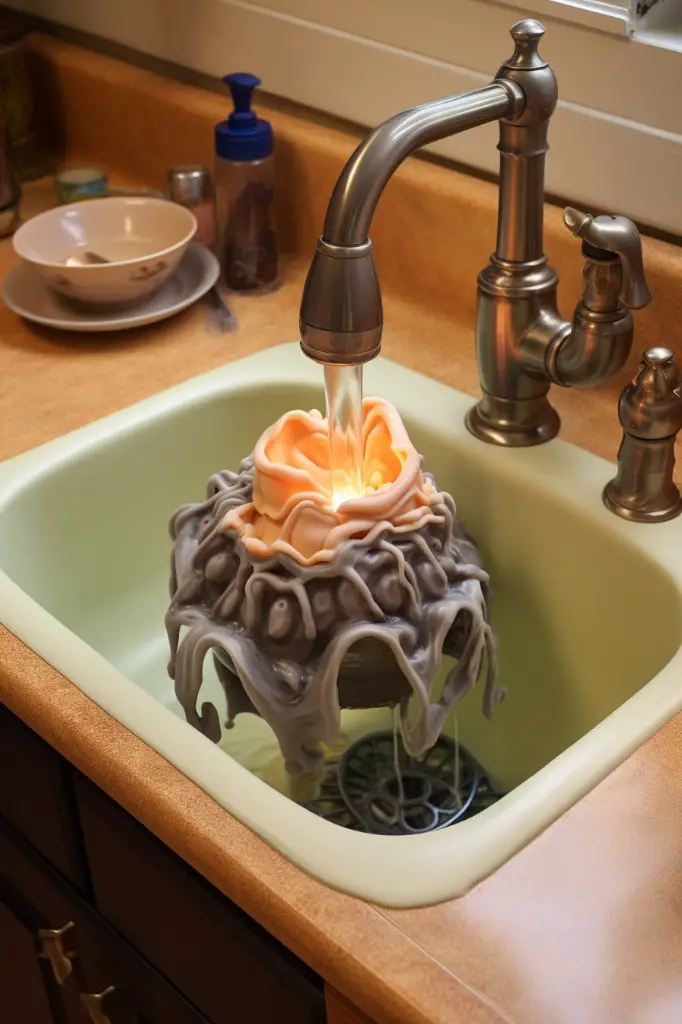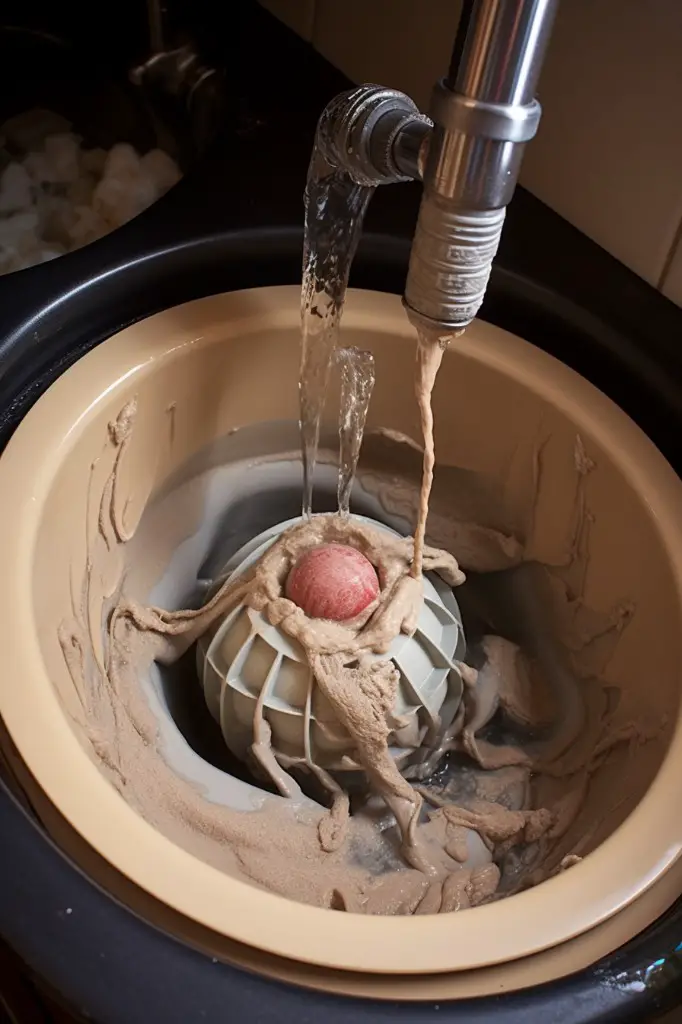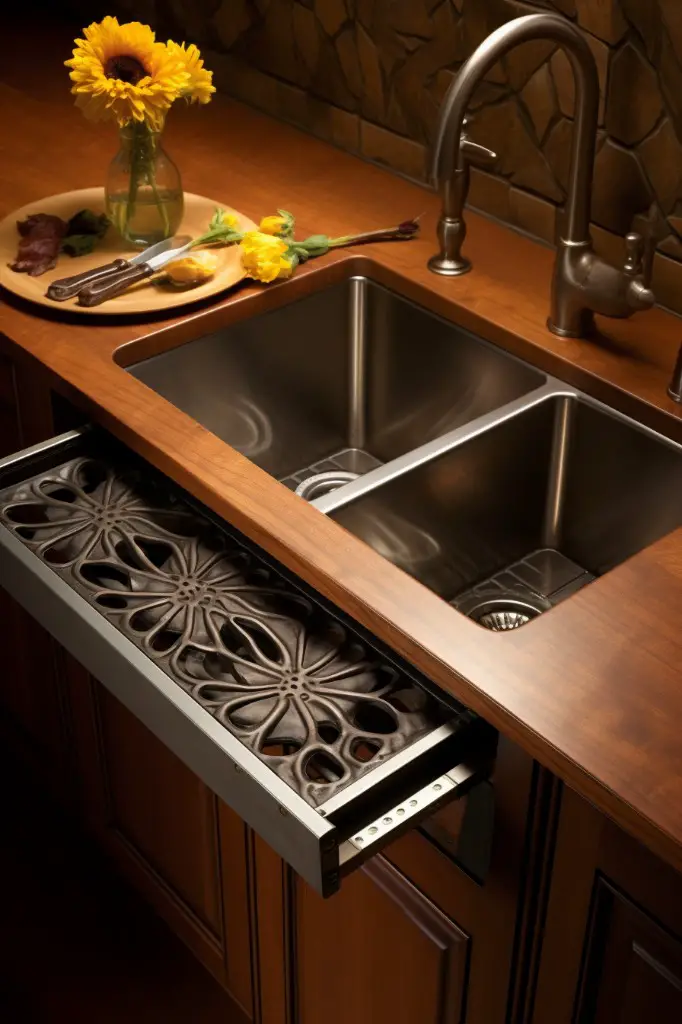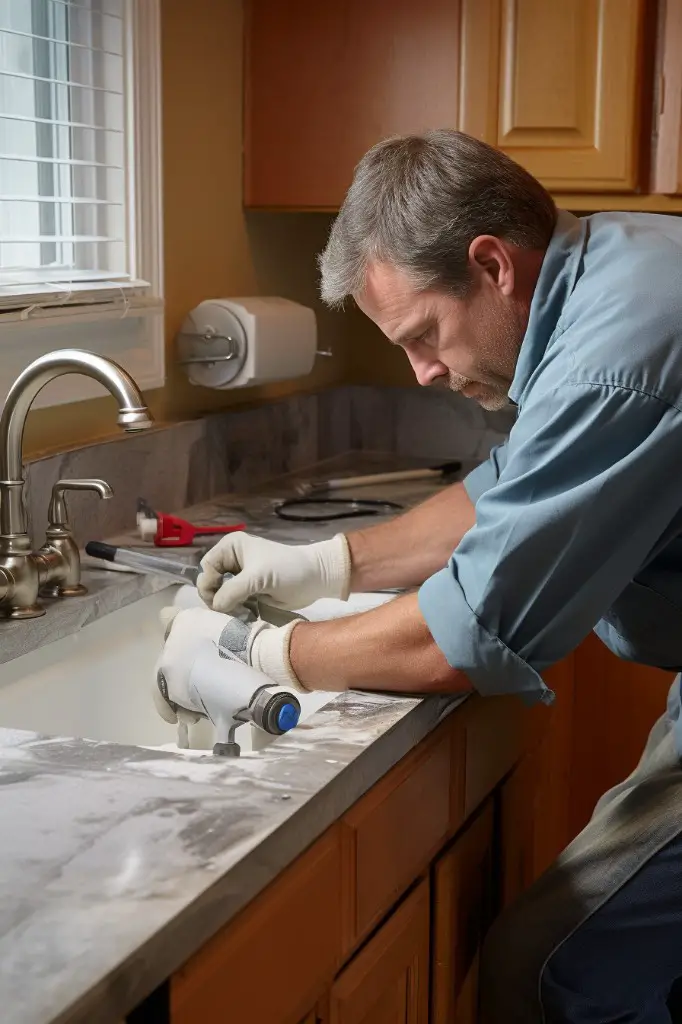Last updated on
Discover the importance of using plumbers putty when installing a kitchen sink drain to ensure a leak-free and secure connection.
Have you ever wondered what that strange putty-like substance is that your plumber uses when installing or repairing a kitchen sink drain? Well, wonder no more! Plumbers putty is a versatile material used in many plumbing applications, including sealing and securing sink drains. But do you really need it for your kitchen sink drain? In this article, we’ll explore the ins and outs of plumbers putty and help you determine if it’s necessary for your specific situation.
So let’s dive in and discover if plumbers putty is a must-have for your kitchen sink drain!
What's Inside
Understanding Kitchen Sink Drains

Kitchen sink drains are an essential part of any kitchen plumbing system. They allow water and other liquids to flow out of the sink, preventing it from overflowing and causing damage to your countertops or cabinets.
Understanding how a kitchen sink drain works is crucial in determining whether you need plumbers putty for its installation.
A typical kitchen sink drain consists of several parts, including the strainer basket, tailpiece, P-trap, and waste arm. The strainer basket sits at the bottom of the basin and catches food particles or debris that could clog up your pipes.
The tailpiece connects to the strainer basket’s underside and extends down into a curved pipe called a P-trap.
The P-trap is designed with a U-shaped bend that holds water in it at all times; this prevents sewer gases from entering your home through your sinks’ drains while still allowing wastewater to flow freely out through another pipe called a waste arm.
Importance of Kitchen Sink Drain Sealing

Without a secure seal, water can seep through the gaps between the sink and drain, causing mold growth, rotting wood cabinets or floors, and even structural damage. An unsealed kitchen sink drain can allow unpleasant odors from your plumbing system to enter your home.
Sealing a kitchen sink drain involves using materials such as plumbers putty or silicone caulk to create a watertight seal around the base of the strainer assembly where it meets with the bottom of your sink basin. This ensures that any water flowing down into your pipes goes directly into them without leaking out onto surrounding surfaces.
Types of Sink Drain Materials

The most common types of sink drain materials include plastic, brass, and stainless steel. Plastic is the most affordable option but may not be as durable as other materials.
Brass is a popular choice for its durability and corrosion resistance but can be more expensive than plastic or stainless steel options. Stainless steel offers excellent durability and corrosion resistance while also providing a sleek look that complements modern kitchens.
It’s important to consider the material of your sink drain when installing or repairing it with plumbers putty since different types of material require different sealing methods for optimal performance.
Proper Installation of Sink Drains

The first step is to ensure that the sink and drain are clean and free from any debris or old putty. Next, you’ll need to apply plumbers putty around the underside of the flange before inserting it into the sink hole.
Once in place, secure the flange with mounting hardware provided by your manufacturer. Be sure not to overtighten as this can cause damage or cracking in your sink basin.
Next, attach any necessary pipes or fittings using Teflon tape on threaded connections for added security against leaks. Test your installation by running water through your new drain system while checking for any signs of leakage.
Do You Need Plumbers Putty for Kitchen Sink Drain?
It’s made from a combination of clay and linseed oil, which gives it its pliable texture and water-resistant properties. When installing or repairing kitchen sink drains, plumbers putty can be an essential tool for creating a secure connection between the drain basket and the sink itself.
One of the primary benefits of using plumbers putty when installing your kitchen sink drain is that it helps prevent leaks. Without proper sealing around your drain basket, water can seep through gaps in the connection and cause damage to your cabinets or flooring below.
If you’re using an undermount sink installation method where there isn’t any hardware holding down the flange on top (such as with drop-in sinks), then plumber’s putty will help keep everything in place.
While some people may opt for silicone sealant instead of plumbers’ putty due to its adhesive qualities; however silicone sealant should not be used alone because over time it will dry out causing leaks again.
Importance of Plumbers Putty
This versatile material creates a watertight seal between the sink and the drain, preventing water from leaking out of the basin or seeping into surrounding areas. Without plumbers putty, you risk damaging your cabinets or countertops due to water damage caused by leaks.
Plumbers putty helps to keep debris from entering your pipes by sealing gaps around the edges of drains. This can help prevent clogs and other plumbing issues down the line.
Plumbers Putty Vs. Silicone
While both can be effective, they have different properties that make them better suited for certain situations.
Plumbers putty is a soft, moldable material made from clay or other synthetic compounds. It’s easy to work with and can be shaped into any form needed for the job at hand.
Plumbers putty is also relatively inexpensive compared to other sealing options.
Silicone, on the other hand, is a rubber-like substance that comes in tubes or cartridges and requires a caulking gun for application. Silicone creates an extremely tight seal but takes longer to dry than plumbers putty.
When deciding between plumbers putty vs silicone for your kitchen sink drain installation or repair project, consider factors such as cost, ease of use, drying time required before using the sink again after installation/repairing process completion etc., as well as personal preference based on experience with either material.
Pros and Cons of Plumbers Putty
Like any product, it has its pros and cons.
One significant advantage of plumbers putty is that it creates a watertight seal between the sink drain and the countertop or sink basin. This prevents water from leaking out around the edges of the drain assembly.
Plumbers putty remains pliable even after drying which allows for easy removal if necessary.
On the other hand, one disadvantage is that over time plumbers putty can dry out or crack which may cause leaks to occur. It’s also not recommended for use with certain materials such as marble or granite since it can stain these surfaces.
Another consideration when using plumbers’ putty is that some people find its odor unpleasant during application; however this dissipates quickly once dried.
Applying Plumbers Putty On Kitchen Sink Drain
Applying plumbers putty is a relatively simple process and can be done by anyone with basic DIY skills.
First, ensure that the area around the sink drain is clean and dry. Take a small amount of plumbers putty (about the size of a golf ball) and roll it into a thin rope shape.
Next, place this rope-shaped piece around the underside lip of your sink’s drain opening. Make sure to press down firmly so that it adheres well to both surfaces.
Once you have applied enough pressure, insert your kitchen sink strainer or basket into its position overtop of where you placed plumber’s putty in order to create an even seal between them both while tightening any screws if necessary.
Wipe away any excess plumber’s putty from around edges using either paper towels or rags until everything looks neat and tidy again!
Which One Should I Use: A Rubber Gasket or Plumber’s Putty?
Both methods are effective in creating a watertight seal, but which one should you use? The answer depends on the type of sink and drain assembly you have.
If your sink has a flange that sits on top of the countertop, then using a rubber gasket is recommended. This type of installation requires compressing the gasket between the flange and countertop to create an air-tight seal.
Rubber gaskets are also ideal for sinks made from materials like granite or marble as they prevent any damage caused by chemical reactions with plumbers putty.
On the other hand, if your sink has no visible rim around its edge (also known as an undermount), then plumber’s putty is typically used instead of rubber gaskets. Plumber’s putty can be applied directly onto surfaces such as stainless steel without causing any damage over time.
When Not To Use Plumber’s Putty
For example, if you have a sink made of natural stone or marble, using plumbers putty could cause discoloration or damage to the surface. In this case, silicone caulk would be a better option.
If you’re installing an undermount sink with granite countertops and epoxy anchors for support instead of clips and screws then do not use plumber’s putty as it may interfere with the bond between the anchor and countertop.
Another situation where plumber’s putty should not be used is when working with plastic pipes since some types of plastic can react negatively to oil-based products like plumbers’ putties which might lead to cracks over time. Instead use silicone caulk specifically designed for plastics.
Can Plumber’s Putty Be Used On Rubber Gaskets?
Rubber gaskets are another common material used to seal kitchen sink drains. They provide a tight and secure connection between the drain and the sink, preventing leaks from occurring.
But can you use plumber’s putty on rubber gaskets? The answer is no.
Plumber’s putty should not be used on rubber gaskets because it can cause damage to the material over time. The chemicals in plumber’s putty can break down the rubber, causing it to deteriorate and lose its effectiveness as a sealant.
If you’re using a rubber gasket for your kitchen sink drain installation or repair, skip using plumbers’ putty altogether. Instead, rely solely on the pressure of tightening down your hardware onto your plumbing fixture with proper torque values specified by manufacturers or professionals.
Alternatives to Plumbers Putty
If you’re looking for an alternative to plumbers putty, there are several options worth considering.
One common alternative is silicone caulk. Silicone provides a strong seal that can withstand exposure to water and other liquids without breaking down over time.
It’s also easy to apply and can be used on a variety of surfaces.
Another option is Teflon tape or thread sealant tape. This type of tape creates a tight seal around threaded connections in plumbing systems, including sink drains.
Rubber gaskets are another popular choice for sealing kitchen sink drains. They come in various sizes and shapes designed specifically for different types of sinks, making them an excellent option if you need something more customized than standard plumber’s putty.
Ultimately the best solution depends on your specific needs as well as personal preference when it comes down to aesthetics or ease-of-use during installation.
What Can I Use Instead Of Plumber’s Putty?
One popular choice is silicone caulk, which can be used in place of plumbers putty for sealing sink drains. Silicone caulk is easy to apply and provides a strong seal that can withstand water pressure and temperature changes.
Another option is using rubber gaskets or washers instead of plumbers putty. These gaskets are placed between the sink drain and the underside of the sink basin, creating a watertight seal without any need for additional materials like plumber’s putty or silicone.
However, it’s important to note that not all sinks come with rubber gaskets or washers included in their installation kit. In such cases where these items aren’t provided by manufacturers as part of your kitchen sink installation kit; you may have to purchase them separately from hardware stores.
While both alternatives work well when installed correctly, they do have some drawbacks compared to using plumber’s putty: they may not provide as tight a seal as plumber’s Putty does; hence leading over time leaks around your kitchen drain area if not properly installed.
Common Installation Mistakes
One of the most common installation mistakes is not using enough plumbers putty or applying it incorrectly. If you don’t use enough putty, water can seep through the gaps between the sink and drain pipe, causing damage over time.
Another mistake is overtightening the nuts that secure the drain in place. Over-tightening can cause cracks in plastic sinks or even break porcelain ones.
It’s important to tighten them just enough so they’re snug but not too tight.
Failing to clean up excess putty after installation may also cause problems down the line as debris buildup could clog your pipes leading to blockages.
Common Issues With Kitchen Sink Drain Installations
There are several common issues that homeowners face when installing their own sink drains. One of the most frequent problems is leaks caused by improper installation or inadequate sealing.
Another issue is using the wrong type of materials for your specific situation. For example, if you have an older home with cast iron pipes, using PVC piping could cause compatibility issues and lead to leaks or other problems down the line.
Not properly aligning all components during installation can also result in drainage issues and clogs over time.
To avoid these common pitfalls and ensure proper installation of your kitchen sink drain, it’s important to follow manufacturer instructions carefully and consider consulting with a professional plumber if needed.
Tips for Proper Kitchen Sink Drain Installation
Here are some tips for installing your kitchen sink drain:
1. Read the instructions carefully: Before starting the installation process, make sure you have read and understood all the instructions provided by the manufacturer.
2. Use proper tools: Make sure you have all necessary tools such as pliers, wrenches, screwdrivers etc., before beginning with installation.
3. Check for leaks: Before installing your new sink drain assembly, check if there are any leaks in existing pipes or connections that need fixing first.
4. Apply sealant properly: If using plumbers putty or silicone sealant during installation, apply it evenly around each connection point to create a tight seal between parts.
5. Tighten fittings securely but do not over-tighten them as this can cause damage to both parts being connected and lead to leakage issues later on down-the-line!
Ensuring Leak-Free Kitchen Sink Drain Connections
A leaking sink can cause water damage and lead to costly repairs. To avoid this, there are a few steps you can take to ensure a secure and tight connection.
Firstly, make sure that all components of the drain assembly are properly aligned before tightening any nuts or bolts. This will prevent any unnecessary stress on the connections which could lead to leaks.
Secondly, use plumbers putty or silicone sealant around the flange of your kitchen sink drain before installing it into place. This will create an additional barrier against water seepage.
Thirdly, tighten all nuts and bolts evenly with pliers or wrenches until they are snug but not over-tightened as this may cause damage.
Check for leaks by running water through your newly installed kitchen sink drain for several minutes while inspecting underneath for signs of moisture buildup or drips from connections.
Maintenance of Kitchen Sink Drain Seals
Over time, the putty may dry out or crack, which can cause leaks. To prevent this from happening, regularly inspect the area around your sink drain for signs of water damage or moisture buildup.
If you notice any issues with your kitchen sink drain sealant, such as cracks in the putty or gaps between the pipes and fittings, it’s essential to address them promptly. You can remove old plumbers putty using a plastic scraper and replace it with fresh material.
In addition to maintaining proper sealing around your kitchen sink drain connections by applying new plumber’s tape when necessary; regular cleaning is also crucial in preventing clogs that could lead to leaks over time. Avoid pouring grease down drains as this will solidify inside pipes causing blockages leading up until they burst open spilling dirty water all over floors! Instead use a strainer basket on top of sinks so food particles don’t go down into plumbing systems where they’ll eventually create problems too!
When to Call a Professional Plumber
If you’re unsure about your plumbing skills or lack the necessary tools and equipment, it’s best to call in the professionals. Here are some situations where you should consider calling a professional plumber:
1. Complicated Installations: If your kitchen sink drain installation involves complex configurations or requires additional modifications to existing plumbing systems, it’s best to leave the job to an experienced plumber.
2. Lack of Experience: Plumbing is not something that everyone can do well without proper training and experience.
Attempting DIY installations without adequate knowledge could lead to costly mistakes.
3. Time Constraints: Installing a kitchen sink drain takes time and effort; if you have other commitments that require your attention, hiring someone else for the job will save you time and stress.
4. Safety Concerns: Working with water pipes involves risks such as electrocution from exposed wires or gas leaks from damaged lines; these hazards require specialized knowledge on how to handle them safely.
While plumbers putty is an essential material when installing most types of sinks drains including Kitchen Sink Drains because they help create watertight seals around fixtures preventing leaks over time but sometimes calling in professional help might be necessary for complicated installations or safety concerns during installation processes.
FAQ
Do I use plumbers putty on a sink drain with a rubber gasket?
No, you do not need to use plumber’s putty on a sink drain with a rubber gasket, as the gasket itself is sufficient to seal without putty.
Why use plumbers putty on sink drain?
Plumbers putty is used on sink drains to seal pipe junctions, preventing water leaks and damage.
Should I use silicone or plumbers putty for sink drain?
You should use plumber’s putty for sink drain, as it remains soft and easy to remove or disassemble over time compared to silicone, which hardens.
What are the key differences between using plumbers putty and silicone caulk for sealing sink drains?
Plumbers putty is a soft, pliable substance used for watertight seals on plumbing fixtures while silicone caulk is a stronger, waterproof sealant used for more durable and long-lasting bonds in sink drains.
How do I properly apply plumbers putty to a kitchen sink drain without a rubber gasket?
To properly apply plumbers putty to a kitchen sink drain without a rubber gasket, roll a generous amount of putty into a rope-like shape, press it around the base of the drain flange, and then tighten the drain assembly.
Can plumbers putty be used with different types of sink drain materials, such as stainless steel, brass, or PVC?
Yes, plumbers putty can be used with various sink drain materials, including stainless steel, brass, and PVC.




